Maryland
| |
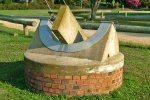 |
St. Mary's City |
Maryland |
USA |
Equatorial Dial |
Dial 374 |
| Cement half-cylinder acting as an equatorial time ring with an inside radius of about 18 inches and a concrete gnomon 5 inches thick that looks more like a piece of lumber set on edge than a gnomon. There is no nodus such that the gnomon shadow is a straight line on the wide equatorial band. The cylindrical inner face is stainless steel with an engraved grid of quarter hours and months. The hours are marked in Arabic every half hour and at every hour is a graphical curve of the equation of time (EOT). Using the time of month, one reads across from the month mark to the EOT, giving the time offset. All in all, a very clear way of integrating the EOT with the hourly shadow. |
| |
| |
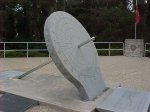 |
St. Petersburg |
Florida |
USA |
Equatorial Dial |
Dial 224 |
| An equatorial dial built by Erickson Monument Co in 1974 for the War Veterans Memorial Park. Dial is 6 feet in diameter made from granite. The gnomon rod of about 3 inches diameter is stainless steel. Hour, half hours, quarter hours and five minute marks show the time. For symmetry, the face has hours marked for the entire 24 hours, though in Florida the excursion of time from 6am to 6pm is relatively small. The hour lines are rotated for the site longitude. |
| |
| |
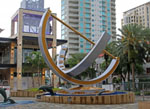 |
St. Petersburg |
Florida |
USA |
Equatorial Dial |
Dial 794 |
| A very large bowstring equatorial dial. The outer diameter of the equatorial ring is 26 feet, the height of the meridian ring is 22 feet above the base and the gnomon rod is 26.5 feet long, making this possibly the largest bowstring dial known at this time. The equatorial ring is marked on two faces with large Roman hour numerals for 7 AM to 5 PM. The dial base includes a large compass rose marked with major directions. |
| |
| |
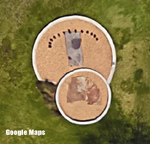 |
St. Petersburg |
Florida |
USA |
Analemmatic Dial |
Dial 822 |
| Sculptor Eric Higgs was originally approached by Robin Reed,who chaired the historic preservation committee for the Historic Old Northeast Neighborhood Association. She was interested in sprucing up a decrepit area where sundials once stood at Vista Point, Flora Park. From the 1930's to the 1970's two different sundials were located on this site. The plan to refurbish the last sundial slowly evolved into a plan for a new sculpture that "escalated into a project for the [waterfront] centennial." |
| |
| |
 |
Stafford |
Virginia |
USA |
Vertical Dial |
Dial 978 |
| This vertical dial is 12 feet tall and nearly 20 feet wide. It is made of quarter-inch aluminum. The white hour lines running from 10am to 5pm are 4-inches wide. They run from the summer to winter solstice. The blue solstices and equinox line are quarter-inch aluminum 5-inches wide. The gnomon base is a yellow sun 10-inches in diameter with a 2-inch diameter gnomon. The nodus on the gnomon is a sphere 6-inches in diameter. |
| |
| |
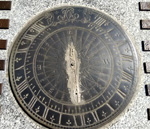 |
Stanbridge East |
Quebec |
Canada |
Horizontal Dial |
Dial 828 |
| The sundial is a 10-inch circular bronze horizontal dial engraved with hours in Roman numerals from IIII to VIII, (4 am to 8 pm) and marks for the half and quarter hours. A compass rose shows 32 compass points. Unfortunately the gnomon is missing. It was originally fastened by two weak screws. Attempts to solder the gnomon in place failed. |
| |
| |
|
Stanstead |
Quebec |
Canada |
Horizontal Dial |
Dial 65 |
| A horizontal dial "sculptural triptych" called "Zig-Zag". Three steel pipes 8x15x13 feet define the sundial. The shadow from its highest point will run along the lower horizontal section exactly E-W at the equinoxes. Stainless steel bolts on the horizontal section serve as hour markers to that time is recorded throughout the year, with the first section of the zigzag serving as the gnomon. The dial-sculpture was funded in part by a 1991 award of a Vermont Community Fund Grant. See NASS Compendium Vol. 1 No. 2, May 1994 |
| |
| |
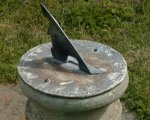 |
Starr's Point |
Nova Scotia |
Canada |
Horizontal Dial |
Dial 407 |
| A small horizontal dial, 8-inches in diameter. The dial is a fiberglass reproduction with metal gnomon upon a cement pedestal. The original dial dates from the 1820s and judging from the reproduction, is in very poor condition. Has Roman numerals, but the hour lines do not agree with the gnomon position. Very difficult to read. North edge of gnomon is cut to resemble a face in profile, possibly in reference to the inscription. On the grounds of the Charles Ramage Prescott House, built 1814 - 1816. Prescott was a merchant and horticulturalist. |
| |
| |
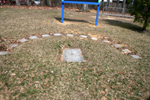 |
State College |
Pennsylvania |
USA |
Analemmatic Dial |
Dial 835 |
| A simple analemmatic dial about 12 feet across. Square unmarked flagstone or pavers mark the hours. The walkway has a concrete base covered by the same flagstone or pavers. The walkway months are embossed in the stone. |
| |
| |
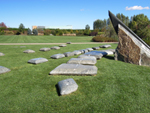 |
State College |
Pennsylvania |
USA |
Horizontal Dial |
Dial 913 |
| The Dr. Joel N. Myers Sundial monumental sundial is truly a masterpiece in time. The 11 foot tall black granite gnomon seems to grow out of a larger granite block. Time is marked by the several rows of low, large flat stones, 25 in all. They are set for summer solstice (first row), equinox (second row that has the stones all in a liner), and winter solstice (only for 10am-2pm. The stones themselves are too large for precise time telling, but the use of colored dots painted on the stones allows you to tell exact civil time using the tip of the sundial's shadow on the solstices and equinox. |
| |
| |
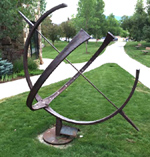 |
Steamboat Springs |
Colorado |
USA |
Equatorial Dial |
Dial 225 |
| This equatorial sundial is a memorial to Barbara Perry Cosel and sits in front of the"Bud" Werner library. A large 6 ft. thin iron equatorial, it is constructed of two 270 degree arcs that intersect at right angles. Time marks are simple detente marks on the equatorial arc. The gnomon is a traditional arrow. At the base of the dial is a plaque containing a graph of the Equation of Time to determine Mountain Standard Time. |
| |
| |
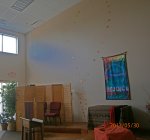 |
Sterling |
Virginia |
USA |
Gnomonic or Projection Dial |
Dial 778 |
| A reflection dial using a mirror in an upper window to project a solar image spot onto the west facing vertical interior wall of a church. Copper medallions on the wall show the spot location at 10:30 AM throughout a year and depict the analemma curve. |
| |
| |
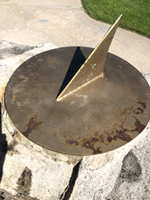 |
Sterling |
Colorado |
USA |
Horizontal Dial |
Dial 968 |
| This horizontal dial is 18 inches in diameter made of painted iron. Parts of the dial face have rusted. The dial is marked hourly from 6am to 6pm to 6pm using Roman numerals at the dial circumference. Hour lines are made using a series of dots. The swept-wing design of gnomon has an angle of 42.5 deg, about 2 degrees higher than the latitude. The dial sits on a limestone bolder. |
| |
| |
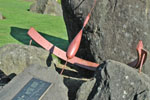 |
Stevenson |
Washington |
USA |
Equatorial Dial |
Dial 707 |
| An approximately four foot diameter equatorial ring dial of natural stone and steel with an analemmic gnomon. Equatorial ring has hour and 15 minute marks with Arabic numeral for PST and PDT. A plaque indicates how to read the shadow of the gnomon, shows primary directions and identifies the dial designer. Plaque includes an analemma showing the equinoxes and solstices and states the dial is accurate within 2 minutes year around. Since the dial includes an analemmic gnomon, no application of EOT correction is needed. |
| |
| |
 |
Stillwater |
Oklahoma |
USA |
Vertical Dial |
Dial 945 |
| This modern etched glass sundial faces nearly due south (declining only 48' East of South) with hour lines from 6am to 6pm marked in Roman numerals. The dial is a large 5 x 9 feet and held extended from the windows behind. The gnomon is a simple brass rod without nodus. No solstice lines or other embellishments mark the clean look of the dial face, making it easier to read from street level 3 stories below. The dial can also be read from inside the building. |
| |
| |
|
Stony Point |
New York |
USA |
Horizontal Dial |
Dial 330 |
| This bronze dial measures 22 inches in diameter, with the gnomon tip 10 inches above the marble dial plate. Hours are marked by Roman numerals, half hours by tics. Dial stis atop a stone and cement base. |
| |
| |
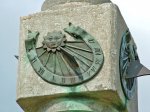 |
Storrs |
Connecticut |
USA |
Pillar Dial |
Dial 85 |
| Waugh memorial dial. Not oriented on cardinal points. It was rotated to avoid tree and adjacent building shadows. Gift of Mr. & Mrs. Kenneth Lynch Sr., the Alumni Association, and funds raised for the purpose. The stone pillar is 12 ft. high. Constructed by the firm of Kenneth Lynch & Sons. |
| |
| |
 |
Stouffville |
Ontario |
Canada |
Vertical Dial |
Dial 730 |
| A 46 inch wide by 52 inch high south-facing vertical dial of high density urethane with a 10 mm diameter stainless steel gnomon. Dial face has hour lines with half-hour marks and Roman numerals. Hour lines are longitude corrected.
A brass plaque containing the dedication, additional information about reading the dial and an equation of time table is mounted on the building wall below the dial. An informative booklet about church sundials is available in the church. |
| |
| |
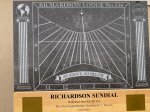 |
Stouffville |
Ontario |
Canada |
Vertical Dial |
Dial 751 |
| A 42 x 72 inch, 10 inch thick, 3300 pound black granite vertical dial on a 5 foot high steel tube pedestal. Gnomon is a 5/16-inch stainless steel shaft with a dowel-type nodus to mark solar declination. Dial shows EDST with longitude correction. Dial face includes hour and half-hour lines, and equinox and winter and summer declination lines. Dial center is the pivot of the compasses in the Masonic Square and Compass emblem, with oak leaves.
Below the dial is a 12 x 72 inch oak plaque inscribed with dedication information and two brass plaques with dial information and EOT graph. |
| |
| |
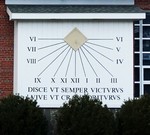 |
Stow |
Massachusetts |
USA |
Vertical Dial |
Dial 48 |
| The dial was originally high on the south gable of a stone building called the Apple Barn that was located on the grounds of Stow's Center School. Extensive renovations and new buildings were done in 2010 and the Apple Barn itself had to be demolished. The dial was moved to the south-facing wall of the new school's southernmost wing. The dial has hour lines from 6am to 6pm with Roman numerals at each hour. The gnomon radiates from a plain diamond in the center of the dial and the dial face is constructed of white painted clabbered wood. |
| |
| |
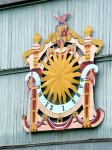 |
Stratford |
Connecticut |
USA |
Vertical Dial |
Dial 86 |
| Large vertical dial at the Shakespeare Festival Theatre entrance. The dial is formed around a large circular sunburst with Roman numerals at the edge. Gnomon is missing. Dial declines east and is non-functional for this position and location. Above the dial is a shield. |
| |
| |
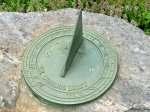 |
Sturbridge |
Massachusetts |
USA |
Horizontal Dial |
Dial 180 |
| A 1 foot diameter cast iron circular plate, with Roman numerals 5 am to 7 pm. Subdivided into 30 min increments on one ring, 10 minute increments on an adjacent one. Fastened with screws to a large rock. Reproduction of an authentic original cast iron dial from the Samuel Pierce House, Middleton, CT. Plaque reads "In grateful recognition for the leadership and service of Edward L. Clifford, Chairman of the Board of Trustees." |
| |
| |
 |
Sudbury |
Ontario |
Canada |
Armillary Sphere |
Dial 359 |
| A monumental half armillary dial in stainless steel. At one end of 'Polaris Boulevard' which includes Terra, a segment of the globe oriented with Sudbury directly at the top. Celeste is a giant (12.8 meter or 42-foot) stainless steel sundial located at the south end of Polaris Boulevard. It consists of two arches, one which represents the equator in the sky, and one which represents the meridian. A large steel pipe makes up the gnomon of the sundial. |
| |
| |
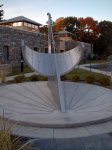 |
Suffern |
New York |
USA |
Compound Dial |
Dial 411 |
| Robert Adzema has designed a 10-foot tall, 12-foot long combination equatorial and horizontal dial made out of stainless steel. The equatorial dial has a wide arc showing hours from 6am to 6pm. At the noon hour is a 31-inch analemma illuminated by a 1/4-inch nodus in a rod gnomon. The pedestal holding the dial and rod is designed as the gnomon for an even larger horizontal ground level dial that surrounds the equatorial dial. For this horizontal dial, the hour lines are made of half-inch stainless steel bars are embedded in concrete. An inscription tells how to tell the time. |
| |
| |
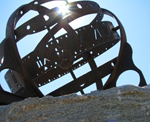 |
Summerland |
British Columbia |
Canada |
Armillary Sphere |
Dial 952 |
| A steel patinaed armillary sphere about 1.5m in diameter, mounted on a low boulder. The dial is marked by roman numerals etched completely through the thick equatorial band. Large holes form the hour moment, with smaller holes for the half and quarter hours. The meridian ring also serves as support for the dial. In addition are arctic and antarctic rings. A ball at the center of the dial has outlines of the continents, reflecting its status as a representation of the Earth at the center of the celestial sphere. The design of a slot mechanism allows the equatorial ring to be rotated by 15° for Daylight Saving Time. A simple Equation of Time plaque attached the boulder has explanatory notes allows correction to civil time. |
| |
| |
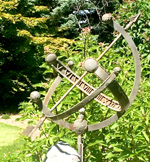 |
Summerland |
British Columbia |
Canada |
Equatorial Dial |
Dial 969 |
| This is a standard equatorial in reasonable condition, mass produced, probably steel, about 2 feet in diameter. As at 2019, it is loose on its base and so visitors are likely to find it out of alignment. It is mounted on a rough stone pedestal decorated with strips of metal reminiscent of plant foliage reaching up around it. |
| |
| |
 |
Sun City |
Arizona |
USA |
Horizontal Dial |
Dial 8 |
| A monumental horizontal dial in a gravel rock garden. Gnomon is 22 feet high, 40 feet long built from a structural steel "I" beam 64 feet long. Gnomon is supported by three concrete triangular legs and is encased in concrete with four shadow-casting style edges. A circular concrete walkway under the gnomon has painted Roman numeral hour markers. |
| |
| |
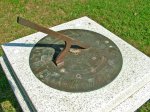 |
Sunderland |
Maryland |
USA |
Horizontal Dial |
Dial 259 |
| A brass horizontal dial 11.5 inches in diameter with a 7 inch high gnomon. The dial is intricately engraved and includes compass points and gradations of the clock to two minutes. Made by "E. Nairne", a London dial maker in the 1750's to 1800. Rector Stephanie Chase Wilson says "I believe it was made specifically for our church as it has the name "All St.s Parish Calvt County" written on the face on the opposite side from "E. Nairne." The oral history of its origins is that it was commissioned by the Rev. Thomas Claggett, rector of All Saints from 1769-1777, and again from 1786-1792. He gave the sundial to the church in thanksgiving for being called as the first Bishop consecrated on American soil on September 17, 1792 in Trinity Church, New York."
"About 15-20 years ago the sundial was stolen from the church, but a quick-thinking parishioner got word out to every antique store within 100 miles and several days later it was recovered. A replica was created and now sits outside the church on a pedestal. The original is under lock and key. The only special care it gets is an occasional dusting. " |
| |
| |
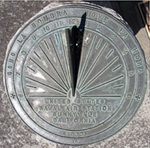 |
Sunnyvale |
California |
USA |
Horizontal Dial |
Dial 1081 |
| Farenholt sundial for U.S. Naval Air Station Sunnyvale CA. This cast bronze dial was designed and commissioned by RADM Farenholt for U.S. Naval Hospitals at bases where he was commanding officer, visited, or had special meaning to him. The dial is 18 inches (46cm) in diameter. The outer chapter ring has the motto, followed by a chapter ring with Arabic hours 6am to 6pm, raised hour lines that radiate from near the foot of the gnomon and short half-hour lines. The gnomon has graceful curves and a star cut-out in the center. Below the gnomon is the naval command name, followed by the commissioning date in the southern portion of the hours chapter ring. |
| |
| |
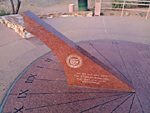 |
Sunset Point Rest Area |
Arizona |
USA |
Horizontal Dial |
Dial 1050 |
| Sitting on a low dais is a beautiful red granite sundial. The gnomon is about 1.5m high and 20cm wide sitting in the center of a dial about 2.5m in diameter. Hour lines radiate from the gnomon foot to the edge of the dais, marking the hours from VI (AM) to VI (PM) local solar time. Inscriptions are on both the east and west side of the gnomon, a plaque and names of those who died serving the citizens of the State of Arizona. |
| |
| |
|
Superior |
Arizona |
USA |
Horizontal Dial |
Dial 105 |
| A small 8 in. bronze horizontal dial with raised Arabic numerals marking the hours. The dial is set on a massive cobble stone and mortar base suitable for sitting upon while watching the hours. |
| |
| |
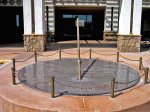 |
Surprise |
Arizona |
USA |
Horizontal Dial |
Dial 574 |
| A 108-inch diameter granite dial face with a 92-inch steel gnomon and nodus. Dial furniture includes a solar noon mark, sunrise and sunset points on the solstices and equinoxes, ecliptic date lines and an EOT graph. |
| |
| |
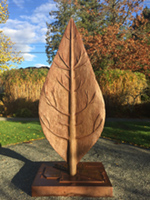 |
Surrey |
British Columbia |
Canada |
Sculpture/Artwork |
Dial 934 |
| The sculpture, titled "Gnomon", is a metal clematis leaf about 9ft tall and 3ft 6in wide at its widest point. It varies from about 1 in at the edge to about 4 in in the middle. The base is marked with cardinal directions and a present map of the neighborhood. There are a series of twelve 9 inch disks arranged around the sculpture set at a radius of 9 ft. The disks are positioned every 30 degrees around the circle, and at the north point, is an additional disk for "12 PST". All components of the sculpture are case iron, set into a graveled area. According to accompanying information,"Gnomon, featured in Fleetwood Park’s perennial garden, is inspired by the notion of a sundial marking time. A gnomon is the central part of a sundial that casts a shadow that marks the passage of time. This artwork tells the story of the passage of time in the growth, change, and appearance of Fleetwood’s historic community landmarks. |
| |
| |
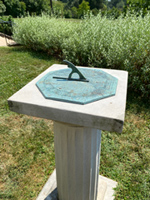 |
Swarthmore |
Pennsylvania |
USA |
Horizontal Dial |
Dial 1018 |
| This octagonal dial was given to Swarthmore in memory of their classmate Howard White Jr. The dial was originally placed in the Scott Arboretum on Parish Lawn but was removed for pathway reconfiguration in 2006. An alum Bob Thompson found that the dial was stored under the bleachers alongside Skallerup Track. n honor of Thompson’s 92nd birthday, the Arboretum returned the sundial placing in in front of Pearson Hall for the next generation of students to enjoy. |
| |
| |
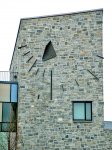 |
Swarthmore |
Pennsylvania |
USA |
Vertical Dial |
Dial 35 |
| Modern design for a vertical dial declining 20.5 deg east on a stone block wall. The gnomon is a right-angled sheet of bronze, casting shadows onto granite hour marks from 6am to 4pm. The dial was designed by Marti Cowan using Waugh's formulae for vertical dials. Frederick Orthlieb, professor and chair of the Dept of Engineering at Swarthmore "had a part in locating the bent-plate gnomon so as to give correct indications on the vertical wall. As installed, the gnomon's indicating edge (which lies on a Polar Axis) casts quite a short shadow in Autumn and Winter and requires some observing skill to make a close estimate of indicated time, but in Spring and Summer the longer shadow moves over the granite hour marks very plainly." A double-line mark at 11am indicates noon during Daylight Saving Time. The second mark is slightly askew if one looks carefully. |
| |
| |
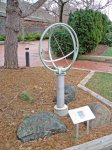 |
Sydney |
Nova Scotia |
Canada |
Armillary Sphere |
Dial 638 |
| An armillary sphere constructed from a large, dual-loop aluminum radio direction finding antenna. Outer ring is 80 cm (31.5 inch) diameter mounted on a 1.3 m (51 inch) pipe pedestal. Hour ring is stainless steel and marked in ten minute intervals showing local apparent time. A nearby plaque provides Equation of Time conversion to standard time. A second small style projects a shadow at noon local apparent time on a second vertical scale to show the sun's declination. |
| |
| |
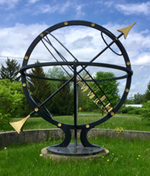 |
Syracuse |
New York |
USA |
Armillary Sphere |
Dial 382 |
| A 10 foot 2 inch diameter armillary sundial made of black anodized steel. The equatorial band is created by two narrow bands holding in open space 10-inch gold colored Roman numerals to grace each hour from 6am to 6pm. The gnomon is a traditional rod with gold arrow and tail flute. The armillary has arctic and antarctic circles, and a prime vertical that extends only to the horizon circle. The prime meridian has 12 gold flowers spaced every 30 degrees. The dial weighs about 8000 lbs and sits on a small concrete base. |
| |
| |
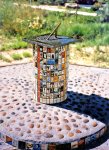 |
Taos |
New Mexico |
USA |
Horizontal Dial |
Dial 493 |
| A copper and bronze horizontal dial about 15 x 15 inches. The dial was built by the Rocky Mountain Youth Corp, an organization the helps direct the energies of "at risk" youth. Base of dial is clad with 2x4 inch glazed tiles made by all the 5th graders in town. There is a compass rose around the base and on dedication day, an area of wet cement was available those present to make an inscription or hand print. |
| |
| |
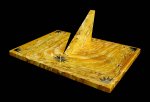 |
Tempe |
Arizona |
USA |
Horizontal Dial |
Dial 23 |
| A horizontal dial from Picture Rock Sandstone with 24k gold-plated inlaid brass fittings, 25 inches wide by 36 inches long, with gnomon 12.5 inches high. Gnomon is 1.5 inches thick. Total sundial weight 110 lbs. |
| |
| |
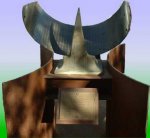 |
Tempe |
Arizona |
USA |
Equatorial Dial |
Dial 75 |
| An equatorial dial designed by R. Newton Mayall with a "curved triangular gnomon over a curved face approximately 1ft. wide. Tells the day of the year and standard time noon." Has a plaque explaining the Equation of Time. |
| |
| |
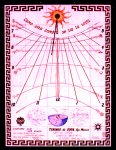 |
Tenango de Doria |
Hidalgo |
Mexico |
Vertical Dial |
Dial 459 |
| A very striking vertical reclining dial 85 x 115 cm created from hand painted tiles, each individually fired in a kiln and assembled at Tenango de Doria by David Canyedo. In addition to hour lines, the dial includes declination lines for the solstices and equinox. The dial includes constellation maps of both the northern and southern hemispheres, a celestial sphere, and rose of winds (compass). The artistry also includes NAHUI OLLIN (the fifth sun which is the era we are living in according to the Aztecs). The dial has an equation of time that allows conversion from local solar time to standard time. The dial was designed to arouse interest of high school students in astronomy. |
| |
| |
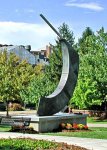 |
Terre Haute |
Indiana |
USA |
Sun Alignment |
Dial 586 |
| Via Solaris, a 20x15x4 foot granite, stainless steel and bronze calendrical dial showing yearly equinoxes and summer solstice. |
| |
| |
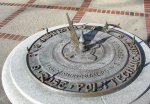 |
Terre Haute |
Indiana |
USA |
Horizontal Dial |
Dial 685 |
| A round bronze horizontal dial with 6 AM to 6 PM hour lines and half-hour lines and Arabic hour numerals. Eight perimeter points and the one central decorative point may represent alignments but no explanation is given. Dial sits on a carved stone column. Base marked 1920 1921 1922 1923. |
| |
| |
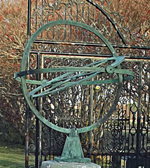 |
Terrel |
Texas |
USA |
Armillary Sphere |
Dial 1049 |
| When is a sundial not a sundial? At first glance it appears to be an armillary sphere, but upon closer inspection, it is missing both a gnomon rod and an equatorial ring to mark the hours. Then, in another view of the dial we see that the angled ring with spokes actually contains hour numbers and could be the missing equatorial ring. Further, it a rod had been attached perpendicular to the ring, and the ring were tilted to the co-latitude, we'd have a working armillary sundial. The missing gnomon rod may have fastened to the meridian ring. Bottom line: with some care, this sundial can be saved and become a working sundial again. |
| |
| |
 |
Thunder Bay |
Ontario |
Canada |
Analemmatic Dial |
Dial 466 |
| A very well constructed analemmatic dial about 24 by 11 feet. The dial may be difficult to find, since it is in the center of a field that is devoted to wild grass of the area. Cement markers are used to show the hours and for the central base showing the months where to stand. The hourly markers are corrected for the longitude of Thunder Bay. The site is visited quite frequently by school children and is a great educational tool for dialing. |
| |
| |
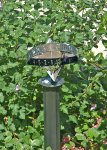 |
Toledo |
Ohio |
USA |
Equatorial Dial |
Dial 621 |
| An equatorial projection dial 18 inches wide atop a 3 foot high fluted steel column. Located on the Anthony Wayne Trail Bridge inside the zoo near its entrance, access requires zoo admission. Dial sits atop a three foot high fluted steel column. |
| |
| |
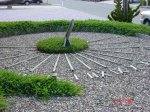 |
Toms River |
New Jersey |
USA |
Horizontal Dial |
Dial 507 |
| A horizontal dial about 22 feet in diameter. The dial base is stone and gravel outlined in shore juniper plants. Treated lumber, now gray through weathering, is used for the both the hour lines and the marking Roman numeral hours. Nicely fashioned with a hub of green junipers in the center surrounding a simple wood gnomon. Builder Richard Perez started off just wanting something a little different?and the sundial emerged in 1992 as the main theme of landscaping. |
| |
| |
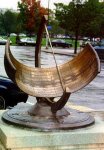 |
Toronto |
Ontario |
Canada |
Equatorial Dial |
Dial 364 |
| The face of this equatorial dial is an arc of a sphere 2 meters in diameter. A nodus on the polar gnomon casts a shadow indicating solar declination. Aligned with the dial is a 15 meter meridian line which passes through the site of the transit instrument of the former Toronto Observatory. |
| |
| |
 |
Toronto |
Ontario |
Canada |
Armillary Sphere |
Dial 413 |
| Armillary dial about 4 foot in diameter. Gnomon rod appears to be missing. Raised Roman numbers show the hours from V in the morning to VII at night. Equatorial strip is about 6 inches wide. |
| |
| |
 |
Toronto |
Ontario |
Canada |
Equatorial Dial |
Dial 414 |
| An equatorial dial with rod gnomon bent into a half analemma. Raised Roman numerals along the equatorial arc from V in morning to VII at night. The gnomon is held by semi-circular arc with pleasing proportions that match the equatorial arc. |
| |